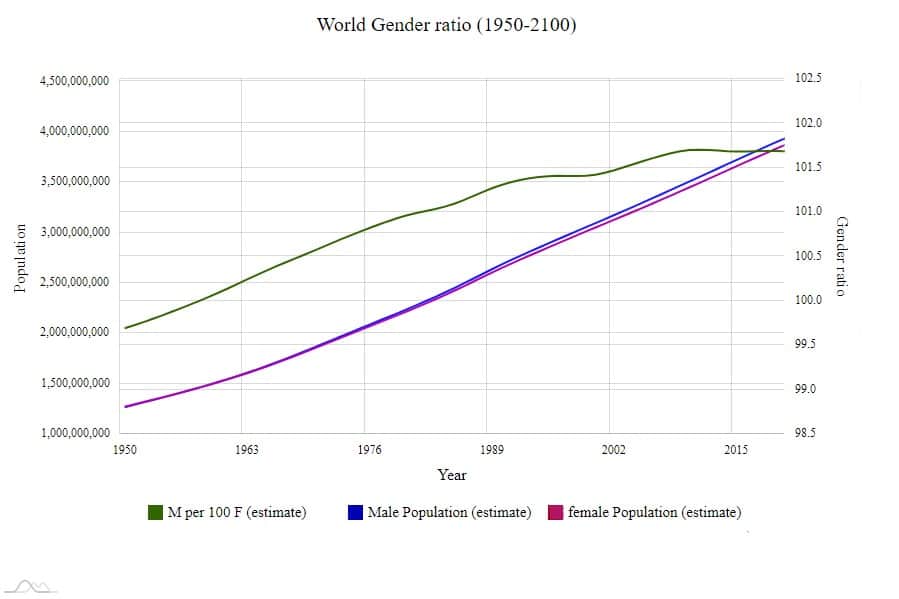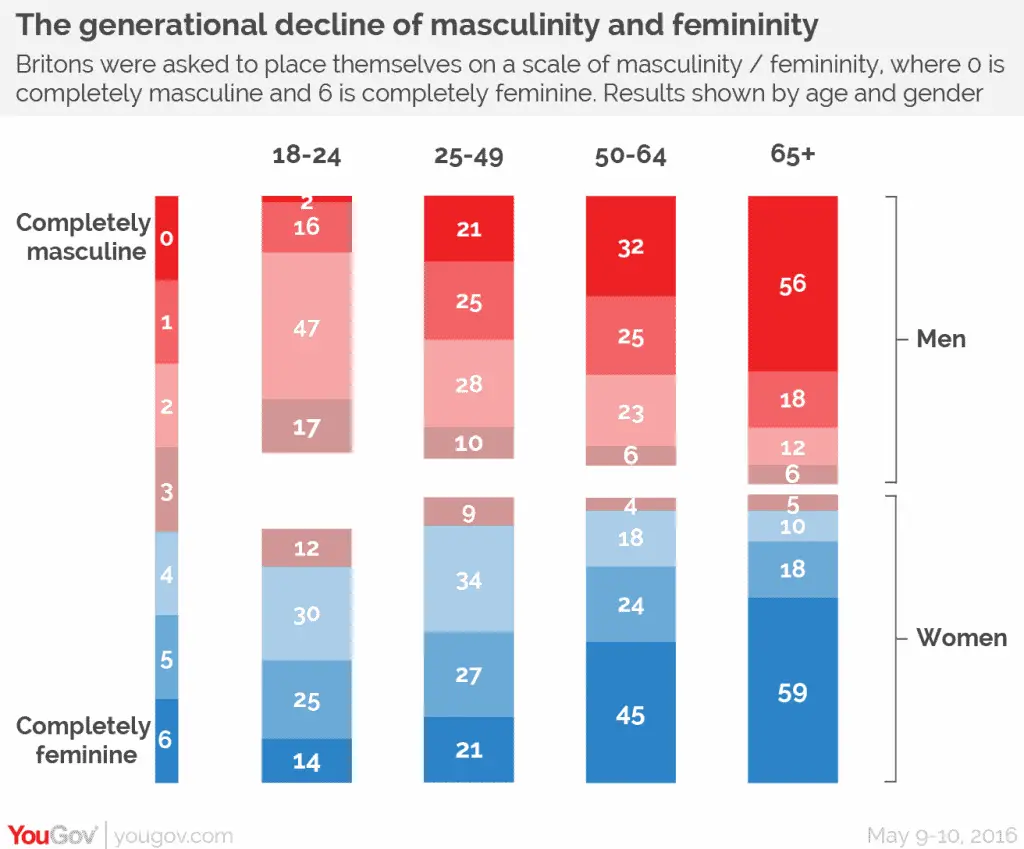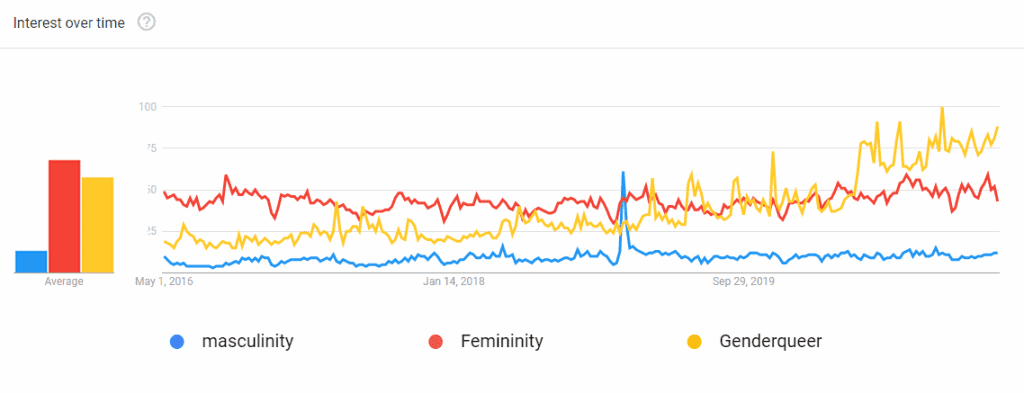Many men today are having an internal crisis of identity. They are left questioning their Masculinity and how they fit into modern society. I also hear from women seeking Masculinity in a partner and finding a lack.
This begs the question, are men less masculine today?
A study by YouGov found 2% of young men feel completely masculine (compared to 56% of those over 65s). Men are becoming more disconnected from their Masculinity, and women feel men are less masculine. Many factors show Masculinity is in decline.
But that is such a broad statement.
To dive into this question about the decline of Masculinity, we must look at how men identify with Masculinity, the popularity of Masculinity, biological factors, and more.
In the rest of this article, I will be sharing facts, figures, and analysis to help us better explore if Masculinity is indeed in decline.
The Gender Ratio of the World
When researching this topic, I wondered if there has been a shift in the gender ratio over the last few decades.
A report by Statistic Times shows that there has been only a slight increase in the Male Population vs. the Female Population. As of 2020, there are 101.69 males per 100 females.

This shows us that if there was a change in Masculinity, it was not created by changing the biological gender of the human race.
Perhaps instead, we will find changes in how society perceives Masculinity, male identity, and cultural changes.
The Decline (Or Expansion) of Masculine Identity
Masculinity is separate from biological gender. Masculinity is a chosen identity and expression. Most men identify as masculine, but that is not always the case. Some women feel they have a strong sense of Masculinity, and some men feel more connected with Femininity.
So this becomes a question of identity and how connected men feel to their Masculine Identity.
A Study by YouGov has revealed a change in how young people perceive their Masculinity. Only 2% of young men felt they were completely masculine. On average, young men found they were only slightly more masculine than feminine.

Comparatively, 56% of men 65+ said they felt completely masculine. This shows that there has been a generational shift in how men connect to their masculine identity.
It’s important to note, what this research show is that gender has become more fluid. Men and women are more likely to see masculine and feminine aspects in their personalities. This doesn’t mean these men act less masculine, just that they see themselves as having an identity that encompasses more than just Masculinity.
Since more women also identify with their Masculinity, you could argue that Masculinity is not in decline but becoming more inclusive and less separated by biological gender.
Is Masculinity less popular?
Another way to explore the change in our culture is by looking at what people are interested in.
This might sound strange at first… but Google Trends is an excellent tool for this.

You can research and compare the popularity of search terms.
When you look at Masculinity, Femininity, and Genderqueer, there is a clear shift in what people are reaching about.
The interest of Genderqueer and Non-Binary is steadily growing. Surpassed Masculinity, and in 2018 becoming more popular than Femininity.
It’s important to keep in mind that all this data tells us is WHAT people are searching, and not WHY.
If I were to take an educated guess, it’s because far fewer men question their Masculinity than women explore their Femininity. A poll by GQ showed that 42% of men have never even talked about their Masculinity.
I believe this lack of self-exploration by men is one of the problems that have lead to such a decline in Masculinity. I find men are much less willing to evaluate the deeper aspects of their identity, psyche, and experience.
How popular Masculinity does give us a unique insight into the question of “is masculinity in decline?” At the very least, it shows us that fewer people are interested in studying and ex0ploring the concepts of Masculinity.
Men are Biologically changing: Decreased Strength
Men of today are very different biologically than men from 50 years ago. Though biology isn’t tied to masculine identity, it can affect how men feel about it.
Society tells us that Men are more Masculine if they have physical strength. Yet, men today are on average 16% weaker than their fathers were at the same age.
Anthropologist Peter McAllister, author of Manthropology: The Science of Why the Modern Male Is Not the Man He Used to Be, noted that aboriginal ice age tribesman could run long distances at the same speed as modern-day Olympic sprinters.
Ancient rowers in Greece could exceed 7.5 miles per hour, which modern-day rowers can only achieve for short bursts.
This has changed been in part our diet, but also our lifestyle. If we consider strength as a key factor to Masculinity, we would see that it has declined in the last 50 years.
It can be helpful to explore the underlying question of what is masculine? Is it strength? Is the Masculinity of 50 years ago the same as today?
Changing Definition of Masculinity
Masculinity is not a fixed definition and changes with the evolution of society. Every generation has a different version of Masculinity, and to hold men today to a standard of 20, 50, or 100 years ago doesn’t help.
Men in ancient Rome complained a lot about how the young people were getting softer. Seneca, a Roman philosopher, believed that people should not themselves “demean their masculinity” with modern dance.
In 1635 Spain, Dominican Francisco de León said, “Where are there men in Spain?” he queries angrily. “What I see are effeminate men .. . I see men converted into women.”‘
In my article on defining Masculinity, I explore what qualities and the complexities of what defines someone as Masculine.
One of the big takeaways from that article is that Masculinity is a shared social definition. It’s something we create as a society, and it changes based on the needs of our society.
When America needed lots of factory workers, it was manly to work in the assembly line.
This changed in the ’90s with the metrosexual male and the 2000’s tech entrepreneur.
The definition of Masculinity also changes depending on where you live. The American south has a different definition than Japan, Africa, or even New York City in America.
When asking ourselves if Masculinity has declined, we need to unpack if the Masculinity of our fathers has declined and replaced with a new version.
In Conclusion
There are many factors to look at to see if Masculinity is in decline. Here is a quick review:
- Young men feel less Masculine than their forefathers.
- There is still about a 50/50 split of women and men in the world.
- Fewer people are researching Masculinity on the internet as compared to Femininity and genderqueer.
- Men are biologically weaker than their forefathers.
- The past definitions of Masculinity might not apply or be helpful in our modern society.
I believe Masculinity is in decline if we use past definitions. But, perhaps we are just in the process of discovering a new expression of Masculinity in the modern age. Maybe we can take the values and virtues of our past and put them in a new context.
I think there is a lot to be gained by creating a more expansive, inclusive, and personal connection to Masculinity.
We have a great opportunity to reclaim our Masculinity as a society. The question is, will we stand up and do the work?




